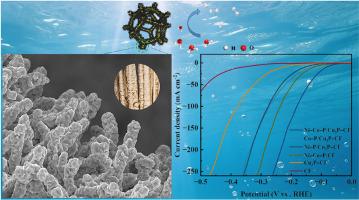泡沫铜支撑的钟乳石状Ni-Co-P /Cu3P异质结构增强碱性析氢反应
IF 8.3
2区 工程技术
Q1 CHEMISTRY, PHYSICAL
引用次数: 0
摘要
开发高性能的非贵金属析氢催化剂是推进碱水电解作为可持续制氢技术的关键。本文通过原位生长、电沉积和低温磷化,在泡沫铜(CF)上生长出自支撑钟乳石状Ni-Co-P / Cu3P-CF异质结构,以最大限度地提高催化性能。在1 M KOH条件下,Ni-Co-P / Cu3P-CF催化剂的过电位分别为82 mV和181 mV,电流密度分别为10 mA cm - 2和100 mA cm - 2, Tafel斜率为54.9 mV dec - 1,稳定性好(测试60 h后过电位损失仅为2 mV)。这主要是由于钟乳石状结构增加了活性位点的暴露,有利于气泡的释放,再加上异质界面结合双金属电子调控,加速了电荷转移,优化了析氢反应中间体的吸附能。该研究强调了结构设计和双金属协同作用在开发高效非贵金属电催化剂中的重要意义,为制氢提供了一条非常有前途的途径。本文章由计算机程序翻译,如有差异,请以英文原文为准。

Stalactite-like Ni–Co–P/Cu3P heterostructures supported on Cu foam for enhanced alkaline hydrogen evolution reaction
Developing high-performance non-noble metal catalysts for the hydrogen evolution reaction (HER) is crucial for advancing alkaline water electrolysis as a sustainable hydrogen production technology. Herein, self-supported stalactite-like Ni–Co–P/Cu3P–CF heterostructures are grown on Cu foam (CF) via in-situ growth, electrodeposition, and low-temperature phosphorization to maximize catalytic performance. In 1 M KOH, the Ni–Co–P/Cu3P–CF catalyst achieves current densities of 10 mA cm−2 and 100 mA cm−2 at overpotentials of only 82 mV and 181 mV, respectively, along with a small Tafel slope of 54.9 mV dec−1 and excellent stability (with merely a 2 mV overpotential loss after 60 h of testing). This is mainly attributed to the stalactite-like structure, which increases the exposure of active sites and facilitates the release of gas bubbles, coupled with the heterointerfaces combined with bimetallic electronic regulation that accelerates charge transfer and optimizes the adsorption energy of hydrogen evolution reaction intermediates. This study highlights the significance of structural design and bimetallic synergy in developing high-efficiency non-noble metal electrocatalysts, offering a highly promising approach for hydrogen production.
求助全文
通过发布文献求助,成功后即可免费获取论文全文。
去求助
来源期刊

International Journal of Hydrogen Energy
工程技术-环境科学
CiteScore
13.50
自引率
25.00%
发文量
3502
审稿时长
60 days
期刊介绍:
The objective of the International Journal of Hydrogen Energy is to facilitate the exchange of new ideas, technological advancements, and research findings in the field of Hydrogen Energy among scientists and engineers worldwide. This journal showcases original research, both analytical and experimental, covering various aspects of Hydrogen Energy. These include production, storage, transmission, utilization, enabling technologies, environmental impact, economic considerations, and global perspectives on hydrogen and its carriers such as NH3, CH4, alcohols, etc.
The utilization aspect encompasses various methods such as thermochemical (combustion), photochemical, electrochemical (fuel cells), and nuclear conversion of hydrogen, hydrogen isotopes, and hydrogen carriers into thermal, mechanical, and electrical energies. The applications of these energies can be found in transportation (including aerospace), industrial, commercial, and residential sectors.
 求助内容:
求助内容: 应助结果提醒方式:
应助结果提醒方式:


